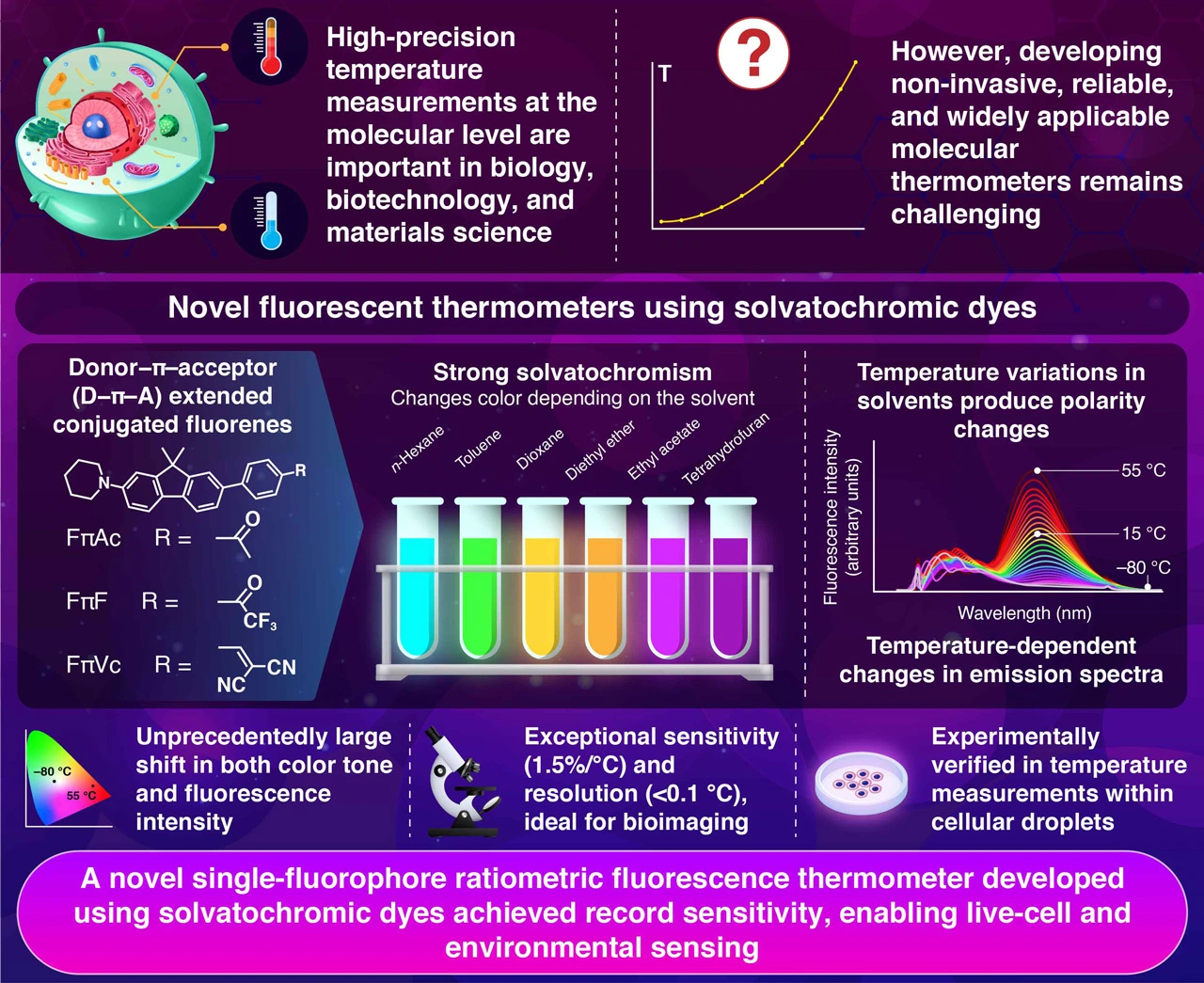Color-Changing Fluorescent Dyes Unlock New Frontiers in Cellular Thermosensing
Scientists develop compounds that change color with minute thermal variations, enabling precise temperature measurements within living cells
A novel molecular thermometer based on color-changing fluorescent dyes achieves unprecedented sensitivity and resolution when measuring temperatures within living cells, report researchers from Institute of Science Tokyo. These compounds can measure minute temperature variations through changes in their fluorescence wavelength and intensity. This breakthrough could reveal previously undetectable thermal processes in cellular compartments, potentially revolutionizing our understanding of temperature-dependent biological functions and aiding in the development of advanced materials.
Fluorescent Molecular Thermometers for Precision Temperature Sensing

Hori et al. (2025) | Journal of the American Chemical Society | DOI:10.1021/jacs.5c01173
Temperature is a critical variable that influences countless biological processes at the cellular level. However, precisely measuring temperatures within living cells remains challenging. Conventional temperature measurement techniques often lack the spatial resolution needed to detect subtle temperature variations in complex microscopic environments. Additionally, many existing molecular thermometers have significant limitations in terms of their sensitivity, resolution, and applicable targets, highlighting the need for innovative approaches and versatile tools.
Against this backdrop, a research team led by Associate Professor Gen-ichi Konishi from Institute of Science Tokyo, Japan, has developed a groundbreaking molecular thermometer using a novel solvatochromic fluorescent dye. Their findings, published online in the Journal of the American Chemical Society on March 5, 2025, demonstrate that this new compound enables high-precision temperature measurements through changes in fluorescence properties.
The researchers designed a series of donor−π–acceptor (D−π–A) fluorophores based on a π-extended fluorene structure. These molecules are specially engineered to change their fluorescence properties in response to their surrounding environment's polarity. When the temperature increases, the polarity of the solvent slightly decreases, which causes these dyes to emit light at different wavelengths and intensities. By measuring the ratio of fluorescence intensities at two specific wavelengths, researchers can precisely calculate temperature changes. This ‘ratiometric’ approach eliminates variables such as dye concentration or excitation light intensity, making it exceptionally reliable for detecting even minute temperature fluctuations within microscopic environments like cellular organelles.
The newly developed dyes exhibited exceptional solvatochromic properties, with shifts exceeding 200 nm between different solvents and emission wavelengths reaching the red region (701–828 nm). Notably, the researchers could perform temperature measurements with a remarkable relative sensitivity of up to 3.0%/°C and a resolution of less than 0.1 °C. “These results represent the highest sensitivity and resolution reported for small organic single-fluorophore ratiometric fluorescence thermometers dispersed in solution, which are ideal for bioimaging,” Konishi notes. Through further mechanistic analysis, the team determined the underlying principles leading to the exceptional solvatochromic properties of the proposed dyes, contributing to future molecular thermometer design.
The team successfully demonstrated the practical application of their molecular thermometer by introducing one of the dyes into living human cell cultures. Using ratiometric confocal microscopy, they confirmed that the dye functions effectively as a temperature sensor within cellular environments, particularly in cellular droplets, where local temperature variations may play crucial roles in biological processes. “This molecular thermometer based on a solvatochromic fluorescent dye is expected to greatly expand the scope of fluorescence thermometry and contribute to uncovering unknown biological phenomena due to its superior spatial resolution, non-invasiveness, and ease of molecular design,” explains Konishi.
Beyond biological research applications, this innovative molecular thermometer also shows promise for analyzing the temperature-dependent properties of polymeric materials and other material systems. The researchers plan to develop a library of fluorescence thermometers based on this strategy, to cover various environments of interest.
By providing unprecedented insights into microscopic temperature fluctuations, these novel dyes may help scientists unravel temperature-dependent biological phenomena and contribute to significant advances in fields ranging from cell biology to chemistry and materials science.
Reference
- Authors:
- Alto Hori1, Atsushi Matsumoto2, Junichi Ikenouchi2, and Gen-ichi Konishi1,*
*Corresponding author - Title:
- D–π–A Fluorophores with Strong Solvatochromism for Single-Molecule Ratiometric Thermometers
- Journal:
- Journal of the American Chemical Society
- DOI:
- 10.1021/jacs.5c01173
- Affiliations:
- 1Department of Chemical Science and Engineering, Institute of Science Tokyo, Japan
2Department of Biochemistry, Kyushu University, Japan
Related articles
Further Information
Associate Professor Gen-ichi Konishi
School of Materials and Chemical Technology, Institute of Science Tokyo
Contact
Public Relations Division, Institute of Science Tokyo
- Tel
- +81-3-5734-2975
- media@adm.isct.ac.jp